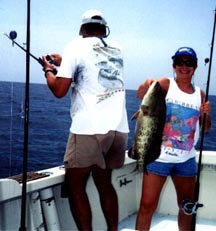Basic Bottom Fishing 
Bottom fishing is probably one of the easiest methods of all to learn if you are new to salt water fishing and want to catch fish, instead of just going for long, usually unproductive, boat rides. In my area of the Gulf, there are several ways we rig our terminal tackle for bottom fishing. The objective is the same for all the different rigs, to take your bait to the bottom and present it to the fish that live there in an appetizing manner. Now what you and I might consider appetizing is probably different than what a grouper considers appetizing, so don’t think that you are about to see "garnishing tips by chef Charlie", I’ve just got some basic rigs so that you can get started fishing without too much experimentation on your part.
Important note: The law now says that you must use 'circle hooks' when bottom fishing.
The first, and probably most commonly used rig is called a "fish finder" rig in some publications. I’ve been using it for thirty+ years, and whoever showed me how to make it probably used it for a lot of years before that, and we never had a name for it. I guess some fancy-schmancy writer coined the name just so he’d have a name for the chapter of his book on bottom fish rigging. It is the simplest rig because it only requires one swivel, one weight, and one hook and you can rig it in a matter of seconds. First cut two to three feet of line off the rod you are using (we call this piece the leader), slip an egg sinker on the standing line (the line going to the reel) and tie on a swivel. Tie the leader that you cut off on the other side of the swivel. Tie your hook to the end of the leader, add bait, drop it to the bottom and catch a fish. Now of course there are a lot of variations to this theme, you can use lighter line for the leader if you would prefer to lose only the leader and hook when a fish takes your bait into the bottom. Usually when fishing for grouper, I use heavier line for the leader, eighty to one hundred pound test tied to forty to eighty pound standing line. This is so the abrasion resistance of the leader is increased and I can pull the fish out of the rocks without breaking him off. This sounds good in theory, right, but reality sets in and I increase to one hundred twenty pound test when the big grouper take over and cut me off even with one hundred pound test leader. You simply have to make a choice, lose more leads when using heavier test leader, or lose more fish when using the lighter leader. Of course when the leader is this heavy, you are using heavy tackle and large hooks in the 6/0 to 8/0 size. For smaller fish such as scamp, porgies, trigger fish, snappers, etc. the leader and standing line are reduced. Usually for these fish my reels are spooled with either twenty or forty pound Team Fish and the leader material is thirty pound Team Fish off the clear leader spools. The hooks I use are 1/0 to 4/0 depending on the size of bait that I’m using, but the rig is the same; weight, swivel, leader, and hook. I haven’t mentioned the weight of the sinker because it depends on the weight of the line you are using, the weight of the bait, whether it is alive or dead, and the speed of the current. I always have an assortment of sinkers from one ounce to eight ounce on the boat and choose the size based on the above criteria, keeping in mind the fact that I need to get my bait to the bottom and keep it there. Just as a general rule of thumb, the most often used sinker size on my boat is 6 ounces for grouper rigs and four ounces for snapper rigs.
The next rig is generally called a "porgy rig" in this area and is quite effective on porgies, grunts, snapper, and any other schooling, medium sized fish. I have seen a lot of keeper grouper caught on this rig, but I don’t recommend it for specifically targeting grouper, it’s just too light. Start with a swivel on the end of your standing line. Cut a four foot piece of thirty or forty pound Team Fish leader material and tie two dropper loops(for this you will have to buy a book on fishing knots, sorry) about eighteen inches apart. The loops should be approximately six inches long. To the end of each loop attach a hook, from 1/0 to 4/0 in size, depending on the species you are after (3/0 is a good size if you have never used this rig). Tie one end of your rig to the swivel on the standing line and to the other end tie a four or six ounce bank sinker (any type of sinker will work, just use whatever you have on the boat). If you can’t figure out how to tie a dropper loop, just use a three way swivel or even pull a six inch long loop and tie a simple overhand knot in the loop to make a dropper. At this point, bait both your hooks (small pieces of squid are generally best), drop them to the bottom and catch fish. This arrangement, with the sinker at the bottom, gives you much more sensitivity to tell when the "dainty nibblers" such as trigger fish and porgies are biting.
A rig that I seldom use is the "break-away" rig. This used to be popular for tarpon fishermen, and it is very effective for keeping your bait on or near the bottom, or any other depth in the water by just changing the length of the light break away line. Starting with a three way swivel attached to your standing line, tie your leader (whatever test you need for the fish you are targeting) to one of the swivel loops. Usually the leader is three to four feet long. To the other swivel loop, tie a foot or so of six pound test line (or sewing thread) with a bank or pyramid sinker of the appropriate weight on the other end. When you fish hits the bait and you jerk to set the hook, the light line with the sinker attached should break, leaving you free to fight your fish without the weight getting in the way. Quite often, with a jumping fish like tarpon or barracuda, the weight on the line ahead of the leader as on a "fish finder" rig, will give the fish the advantage by helping him throw the hook out of his mouth when he jumps and shakes his head. Another method of letting the sinker break away is to use soft copper rigging wire, tied to your sinker and then lightly looped around the swivel between the standing line and your leader. Only loop it enough to hold the sinker on in the current you are experiencing, but loose enough to break away when the fish takes your bait.
The last one I call the "party boat " rig, because you will see it on almost every party fishing boat that you get on. The standing line is usually sixty pound test and a sinker (usually six ounces on the west coast) with swivels molded in is attached to the end of the standing line. Then forty pound test leader is attached to the other swivel and the hook is tied to the end of the leader. The only difference between this and the "fish finder" rig is the swivel type sinker. The fact that the leader material is lighter than the standing line means that the boat will lose less of the expensive sinkers when the anglers get hung up in the rocks, and get hung up you will, because all of the off shore bottom fish on the west coast that we target live on rocky bottom.
There are many other variations of bottom rigs used in Florida for surf, bridge, and pier fishing, but this little assortment should prove to be all you will need for bottom fishing anywhere you go. Next I will give you the three basic rules for bottom fishing that have served me well for many years.
1. When using a conventional reel (not a spinner), keep your thumb on the spool to avoid tangles as you let your line to the bottom. (All these fish live and eat on the bottom, and that’s why we call it "bottom fishing".)
2. When you feel a nibble, raise the rod tip high and reel like crazy. With circle hooks you should NOT jerk.
3. If everyone around you is catching fish and you don’t feel any nibbles, reel up and check to see if you have any bait. You must have bait in order to catch a fish.
But you should never forget the most important rule (#2) for catching bottom fish; when you feel a nibble or a jerk, you must lift the rod tip upwards (we used to say it takes a jerk on both ends of the rod to catch a fish, but not using circle hooks; if you jerk, you will lose the fish).
The bag and size limit changes occasionally, so be sure to check them before you go fishing (click here)
Tight lines and good fishing.
Capt. Charlie


